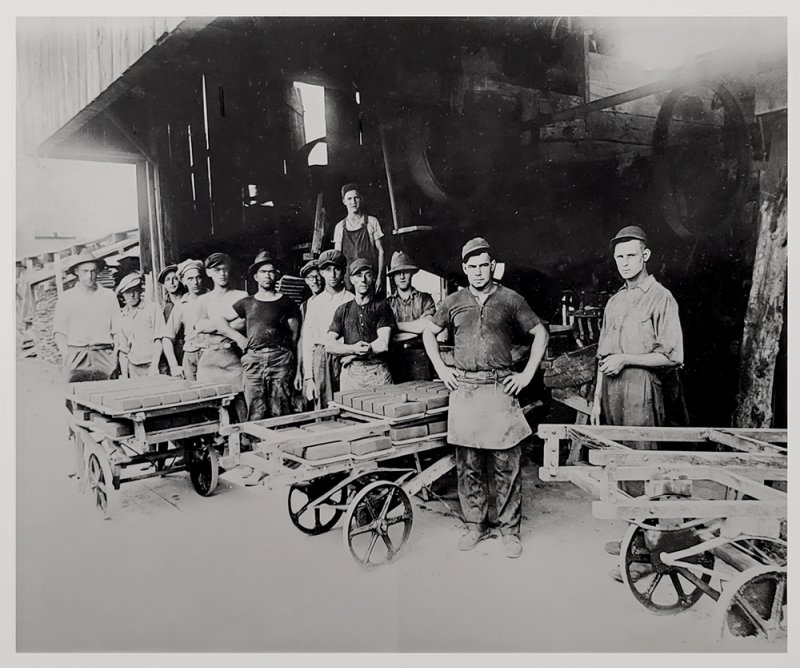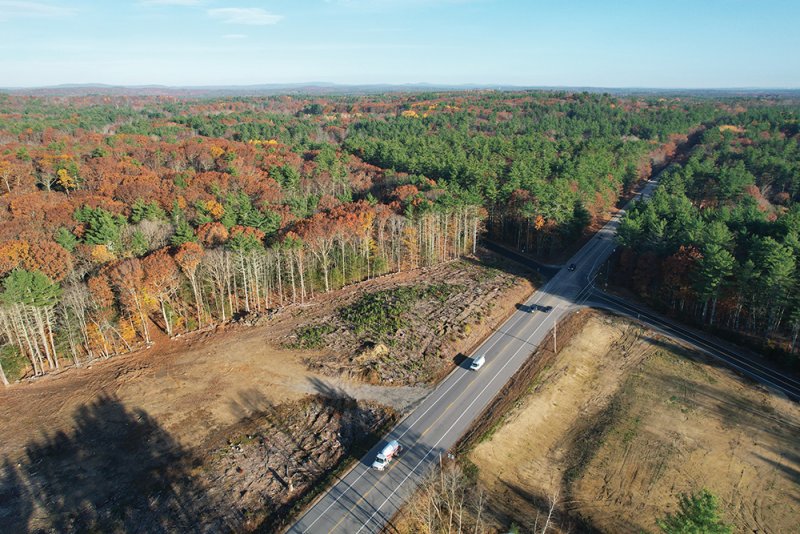
As recently as 20 years ago, Epping was a sleepy town on the banks of the Lamprey River once known for brickyards, shoe manufacturing and agriculture—all of which were fading amid changes in the national economy and the extension of the Massachusetts housing market into Southern NH.
Located at the intersection of NH’s two busiest state highways, Route 101 and Route 125, Epping was primed for development to fill the vast open spaces left by the closed brickyards, shuttered Nike shops and uncultivated farmland.
“It was a very quiet, very low-key kind of place, like Thornton Wilder’s ‘Our Town’ or Mayberry RFD,” says Susan McGeough, whose family is now into its sixth generation as Epping residents. That all changed with the widening of Route 101 to four lanes, completed in 2000.

Employees of one of Epping’s many brickyards in the early 1900s. Bricks were a major industry export from Epping for the greater part of a century. (Courtesy of Epping Historical Society)
With the widened highway going east and west, development creeping north from Massachusetts, and a new county courthouse in neighboring Brentwood (opened in 1997), the stage was set for Epping to truly become the “Crossroads of NH” or even “The Center of The Universe,” as a town bumper sticker proudly proclaims.
The town’s fate was up for grabs.
Wheelabrator-Frye wanted to build a trash-to-energy plant on the site where Walmart is now located. A Connecticut company wanted to build a power plant that would burn shredded tires on the property now occupied by a Market Basket and Beach Plum restaurant. The state Department of Environmental Protection licensed a 7-acre chemical waste storage facility operated by Keefe Environmental Services from 1978 until 1981. That turned into an EPA Superfund site that took years to clean up.
“We could have had Wheelabrator burning trash on one side of 101, and another operation burning tires on the other side,” says Mark Vallone, a lifetime resident, former teacher, school principal and now state representative. “It’s a blessing that we have the commercial operations there now instead, offering people jobs and all the services or products you could think of.”
Vallone is referring to the retail development that now extends from the Brentwood town line south of the 101/125 intersection to the crossing of the Lamprey River at Route 27 on the way to Nottingham. The most prominent are the Market Basket and Beach Plum development south of the intersection (Brickyard Square); the Walmart Supercenter and Lowes Plaza to the north (Epping Crossing), and the Cumberland Farms and Valvoline development further up the highway – all built on land that once hosted the brickyards for which Epping was famous.


Above: Mark Vallone teaching social studies and coaching soccer in 1982. Below: Vallone currently serves as a
NH state representative. (Courtesy of Mark Vallone)
Inevitable Development
“It was kind of inevitable,” says McGeough, who taught in Epping schools for 30 years, served on the Select Board, was a two-term state representative and in February stepped down as chair of the Planning Board. “I often think of Dan Harvey, a large landowner who just died last year at near 100. He always referred to Epping as a sleeping giant because of the proximity of 101 and 125.”
In 2000, Walmart first sought approval for construction in Stratham or Exeter, but organized opposition in those communities drove the giant retailer to look westward at Epping.
Rob Graham, now a Nottingham resident and commercial real-estate developer, was owner of a local pizza shop at the time and was encouraged by McGeough to get involved and run for the Planning Board. “The site Walmart wanted was the best site they could have built on at the time, and that helped,” recalls Graham. Having traveled to Exeter or Raymond to do business for years, Epping residents were anxious to have a supermarket and shopping center of their own, he says. “We really didn’t have a lot of pushback in town. We instituted a flexible use permit for that site, and it developed very quickly.”
Developers worked with town boards to extend municipal water and sewer, implement intersection and highway improvements, and mitigate wetland impacts. The water and sewer improvements that led to the opening of Walmart in 2004 set the stage for the development of Brickyard Square in the ensuing five years.
Diversified Employment
While Walmart and Market Basket have become the major employers in the community, along with the scores of smaller retail and service providers that they attracted, vestiges of the old Epping remain.
“There are a lot of owner-operated small businesses in Epping,” says Graham, “everything from farming to contracting and construction to machine shops,...the types of things that are the foundation of Epping—a bootstrap, hardworking town.”
The variety and size of its retail and service offerings have made Epping a shopping destination for nearby communities, including larger towns like Raymond and Exeter. But it would be a mistake to paint Epping as just another retail strip.
“It’s a small part of the community,” says Graham. “We all wanted to boost the tax base and we did that, but the story of Epping is one of balance. We have a solid school system, local people who take government seriously and are active in it. We have young families; retired families … a real mix.”
McGeough says the development helped stabilize the tax rate for Epping, which was a “property poor” town, with a heavy tax burden on residential properties and a lack of commercial properties to tax. Once a town with one of the highest equalized property tax rates in the state, Epping now ranks somewhere in the middle, with an equalized rate of about $17 per thousand of valuation. It’s not the $7 to $12 range seen in property rich communities like Rye and Portsmouth, but it’s not in the $24 to $29 range of Colebrook and Claremont.
“The good thing is that we’ve been able to stabilize taxes and haven’t seen the huge increases other areas have seen,” says McGeough. “But at first it was a disappointment to most of the people, who were looking forward to bigger tax relief.”
There was increased revenue, but much of it was directed to cover increased demand for municipal services like utilities, police and fire, required by such expansive development.
Open to Housing Development
Epping was once viewed as the outer ring of Seacoast-area housing, and therefore on the more affordable side. Recently, however, home prices in Epping are more likely to be around the median for the state, now at $525,000, according to the New Hampshire Board of Realtors.
The real estate website Redfin classified Epping as a “competitive” housing market, quoting the average sale price of a home there at $490,000 in January.
“It’s nice to have all this shopping and a movie theater and a number of different restaurants, but it brings in a lot of people,” says McGeough. The population of the town has more than doubled since 1980, from 3,460 to 7,223.
“The housing development in the last 20 years has been incredible, all the subdivisions. On my road alone, there have been at least eight new subdivisions, some small, some huge,” says McGeough. “I get people asking me all the time, when are you going to subdivide your land,” she says.
The growth has enabled Epping to attract families. Enrollment at Epping schools has been declining, but at a rate much lower than the state average.
Self-Contained School System
Vallone, who served as both school teacher and principal in the town, says the Epping school system, entirely self-contained, is another of the town’s assets. In the early 2000’s, the town voted down a proposal to form a district with Fremont by five votes.
“Epping still has a strong small-town identity in part because we still have a high school,” says Vallone. “It’s a small high school and it costs a lot of money to run that high school, but people are willing because you get a different education when you are in a small school. You have a much stronger sense of identity and community.”
Epping also has something that a lot of NH communities lack these days—young people who grow up in the community and choose to live there or nearby as adults.
“When you own a restaurant in town, you understand the families,” says former pizza shop owner Graham, “and we saw the kids from the time they were children until the time they brought in their children. In my dentist’s office, it’s the dentist’s son seeing me.”
McGeough has seen the generations pass through her classroom. “It’s a mix,” she says. “There are a lot of people who have stayed here and are raising their children here. When I was teaching, I would have the children of my former students, which was always fun. Some do leave, but a goodly number have stayed.”
Epping didn’t just survive the demise of manufacturing; it thrived by fighting off development that could have polluted the town and embracing development that made it a destination community. Thanks to folks like McGeough, Vallone and countless others, it did that while maintaining its historical town center, putting hundreds of acres into conservation, allowing for diversified housing and maintaining its own school system.
As NH works to create communities where people “stay, work and play,” Epping stands as a model for how to get it done.
Future Development in Epping
 The clear-cut acres off of Route 125. (Courtesy of Michael Fecteau)
The clear-cut acres off of Route 125. (Courtesy of Michael Fecteau)
Part of Epping’s success has been the availability of buildable land with good highway access and an open-minded approach to working with developers.
Here are some areas in Epping where major developments are expected in the months ahead:
• Developers Michael Fecteau and Michael Gareppy are meeting with the Planning Board this month seeking approval for a commercial landscaping operation to be located on 7.5 acres on Route 125, heading north toward Nottingham. The land has already been clear-cut.
• Fecteau also owns a corner lot across from the Shell station at the intersection of routes 125 and 27, where he hopes to attract a hotel, restaurant and bank to a multi-use development.
• Lewis Builders in Salem recently began selling 166 condominiums on 200 acres off Route 27 just west of the town center, called Pleasant View Farm.
• A 315-unit apartment project that includes 64 workforce units is being developed on Martin Road, behind the Brickyard Square area. The state’s Housing Appeals Board overruled Epping’s Zoning Board, which initially denied a variance.
• There are 100 new houses being built on Fogg Road in an over-55 development.
• A 40-unit workforce housing project has been approved on Route 27, pending water and sewer availability.
• Developer Susan Conway still owns acreage behind Walmart and Lowes that she is trying to sell for development.
Epping land use boards are good to work with, “as long as the development is in the correct zone,” says Fecteau, who along with partners owns 18 properties in town. “People sometimes have to get variances to build the density they would like, but Epping is reasonable to deal with from a developer’s standpoint. They are concerned and want to make sure things look right and the developers do a good job.”

 Current Issue - May 2024
Current Issue - May 2024